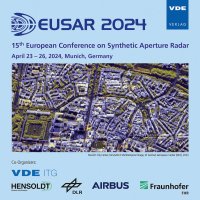Moving Target Detection in Coherent Clutter with Reverse-Path Multistatic SAR
Konferenz: EUSAR 2024 - 15th European Conference on Synthetic Aperture Radar
23.04.2024-26.04.2024 in Munich, Germany
Tagungsband: EUSAR 2024
Seiten: 6Sprache: EnglischTyp: PDF
Autoren:
Andre, Daniel; Watson, Francis; Finnis, Mark
Inhalt:
Synthetic Aperture Radar (SAR) is a side looking remote sensing radar imaging mode, and due to the SAR image formation process being based on the assumption of a stationary scene, target motion causes signature defocusing and displacements. In particular, targets with motion towards the radar, i.e. moving at constant speed in a direction towards and perpendicular to a monostatic radar trajectory, appear both focused and displaced in azimuth in corresponding SAR images. We propose the use of a reverse-path multistatic SAR configuration, consisting of one co-located transmitter/receiver travelling with azimuth angular velocity ω, and a second receiver travelling in the opposite direction with angular velocity -3omega, at a similar grazing angle and with the centre of each SAR aperture approximately co-located. The monostatic and bistatic apertures then cover close to the same extent in K-space, but have filled it in a different azimuthal direction from one-another during the simultaneous collections. This results in a pair of images which have moving target displacements in opposite directions, and which should also be suited to coherent subtraction of ground clutter, allowing detection together with SAR resolution imaging of range-moving targets against strong background clutter. We present results, both simulated and measured in the Cranfield University ground-based SAR laboratory, showing the effectiveness of the method in detecting and imaging of moving targets against strong clutter.


